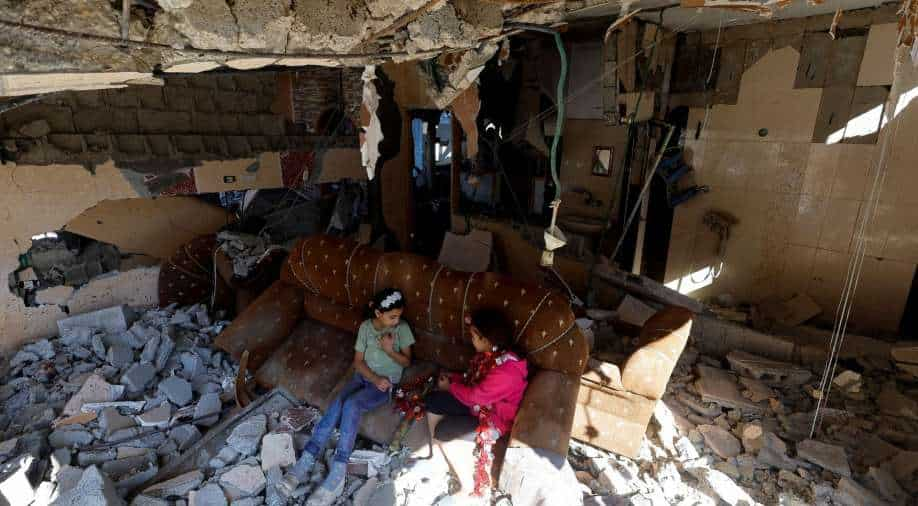Hamas-Israel war: As war rages, a Middle East peace fantasy returns
Story highlights
Control of Gaza went to Hamas, whose militants started the current war on October 7 by breaking through the supposedly impenetrable wall that separates Israel and Gaza, massacred 1,200 civilians and abducted more than 240 to keep them as hostages.
After years at the bottom of the foreign policy priority lists in Washington and European capitals, the “two-state solution” for one of the most intractable problems of the Middle East is high on the agenda again. Alas, it looks further from reality than ever.
The underlying idea is simple: create two states, one for Palestinians and one for Israelis to live side by side in peace. The concept is rooted in a United Nations Security Council resolution, 242, passed after the end of the 1967 war between Israel and a coalition of Arab states.
It stipulated the “withdrawal of Israeli armed forces from territories occupied in the recent conflict.” These were Gaza, the West Bank, the Golan Heights and East Jerusalem. Israel ignored the resolution but in 2005 disengaged from Gaza, dismantling 21 Israeli settlements and withdrawing settlers and army units.
trending now
Control of Gaza went to Hamas, whose militants started the current war on October 7 by breaking through the supposedly impenetrable wall that separates Israel and Gaza, massacred 1,200 civilians and abducted more than 240 to keep them as hostages.
Under a temporary truce deal worked out through Qatar, Hamas has released more than 80 of the hostages in return for Israel freeing 180 Palestinians from prison. Israel has vowed to continue its campaign to wipe out Hamas once all the hostages have been freed.
Follow this live blog for all the latest updates on the Israel-Hamas war
There will be no peace until Hamas is “destroyed,” Israeli officials say. More than 13,000 Gazans, mostly civilians, have so far died, according to the Gazan Health Ministry
The enormous bloodshed, the prospect of more to come, and a humanitarian crisis termed catastrophic by aid agencies prompted the revival of the two-state concept. US President Joe Biden raised it during a visit to Tel Aviv at the height of a ferocious Israeli bombing campaign.
“As hard as it is, we must keep pursuing peace," he said. “We must keep pursuing a path so that Israel and the Palestinian people can both live safely, in security, in dignity, and in peace. For me, that means a two-state solution.” Biden repeated that call ten days later in an op-ed article in the Washington Post.
That was followed a week later by agreement on the need for a two-state solution at a meeting in Barcelona by the Union for the Mediterranean, a 43-member grouping of European, North African and Middle Eastern countries. However, Israel did not participate.
European Union foreign affairs chief Josep Borrell said during the meeting in Barcelona that all EU members thought this was the best way to peace.
This is easier said than done. Among the biggest obstacles: Israeli settlements on the West Bank, the obvious area for a Palestinian state.
In 1993, the year of the Oslo Accords, the first direct Palestinian-Israeli peace agreement, the population of Israeli settlers on the West Bank totalled 111,000. There were 152,000 in East Jerusalem and around 12,000 in Golan Heights.
Thirty years later, more than 500,000 Jews live in 144 settlements in the West Bank, 200,000 in East Jerusalem, and 20,000 in the Golan Heights.
The term “settlement,” by the way, conjures up mental images of people living in converted buses or rough cabins. This is not the case. The biggest “settlement”, Ma’aleh Adumim, has 40,000 inhabitants, a mayor, a municipality, and a mall. It was founded in 1975, grew steadily, and has been called “the town that broke the two-state solution.”
A look at a map of the West Bank explains why it would be near-impossible to create a contiguous territory that could be a Palestinian state. There is an Area A, where the Palestinian Authority has full civil and security control. In Area B Israel has ultimate security control but the PA has some police powers. In Area C, the largest, Israel is in full control.
The logistics of untangling this arrangement are complex and none of the US and European leaders calling for a two-state solution has come up with a plan on how to do this.
The Israeli government under Benjamin Netanyahu has promoted the addition of settlements. The cabinet includes a settler, National Security Minister Itamar Ben Gvir, who announced a few days after the Hamas attack that his ministry had begun distributing assault rifles to arm civilian security teams.
According to the UN’s humanitarian office, attacks by settlers on Palestinians have risen sharply and there are an average of eight incidents of settler violence a day since Hamas’s killing spree. Settlers attacking Palestinian civilians have little to fear.
Also watch | Israel-Hamas War: Youngest captive 10-month old Israeli hostage killed by Israeli airstrike: Hamas
They are under the protective umbrella of Ben Gvir and members of his far-right Otzma Yehudi party, a driving force of a campaign to expand Jewish settlements in lands Palestinians consider theirs for a future state.
Each new settlement undermines prospects for the two-state solution Washington and its European allies see as the only way to peace. And there are plans to bring in more Jewish settlers – permits for 13,000 new housing units have been approved or are pending.
Which explains the word “fantasy” in the headline of this story.
(Disclaimer: The views of the writer do not represent the views of WION or ZMCL. Nor does WION or ZMCL endorse the views of the writer.)

















